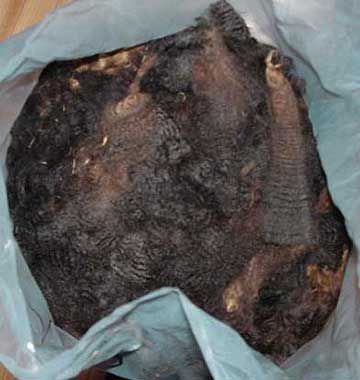
Tenderness
Tenderness shows a definite localised thinning of the fibre diameter due to stress, i.e. the hot, dry Summer months, lack of nutrition, drought. Certain processing operations, notably carding, are mechanically sever and a considerable amount of fibre breakage may occur with tender fleeces. Sometimes it is hard to recognise by sight so a little test is required by tugging or flicking with a finger while the staple is held under tension between the two hands. This applies to wool, mohair and alpaca.
Cotted or Matted
This is a result of extensive and sometimes very severe entanglement of fibres. Cotted fleece is often badly weathered, causing breakages throughout the fleece when carding. This applies to wool, mohair and alpaca.
Canary Yellow
Staining occurs when a period of high temperature follow a thorough wetting of the fleece. This discolouration is very serious because it is not completely scourable. This applies to wool only.
Weathered Tips
This can apply to both white and coloured fleeces, though mainly coloured. It describes where the tips have been bleached by the sun, making them tender, or on slightly overgrown fleeces where harsh conditions have caused tender tips.
Kemp and Medullated Fibres
These fibres are harsh-handling and lack strength and elasticity. Kemp is short, coarse, straight, smooth (lacking serration), brittle and tapering at both ends, also flat white in colour. Medullated fibres are spongy, air filled cells. In appearance they are long with a hollow look. Both kemp and medulla are difficult to control in spinning and dyeing.
This applies to wool, alpaca and mohair.
Copyright © Tracy Bradberry
